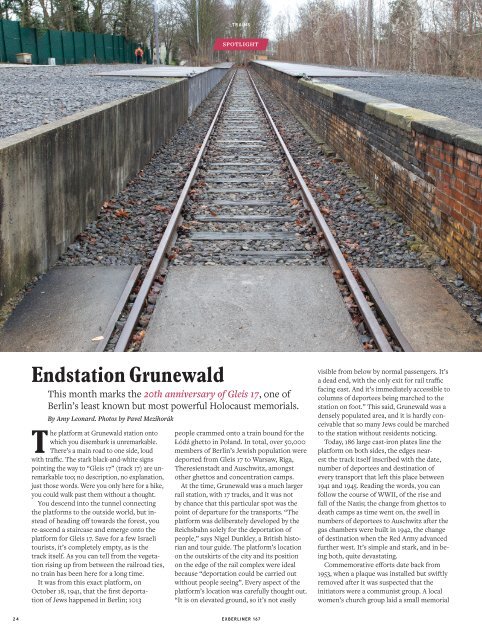Exberliner Issue 167, January 2018
Create successful ePaper yourself
Turn your PDF publications into a flip-book with our unique Google optimized e-Paper software.
TRAINS<br />
SPOTLIGHT<br />
Endstation Grunewald<br />
This month marks the 20th anniversary of Gleis 17, one of<br />
Berlin’s least known but most powerful Holocaust memorials.<br />
By Amy Leonard. Photos by Pavel Mezihorák<br />
The platform at Grunewald station onto<br />
which you disembark is unremarkable.<br />
There’s a main road to one side, loud<br />
with traffic. The stark black-and-white signs<br />
pointing the way to “Gleis 17” (track 17) are unremarkable<br />
too; no description, no explanation,<br />
just those words. Were you only here for a hike,<br />
you could walk past them without a thought.<br />
You descend into the tunnel connecting<br />
the platforms to the outside world, but instead<br />
of heading off towards the forest, you<br />
re-ascend a staircase and emerge onto the<br />
platform for Gleis 17. Save for a few Israeli<br />
tourists, it’s completely empty, as is the<br />
track itself. As you can tell from the vegetation<br />
rising up from between the railroad ties,<br />
no train has been here for a long time.<br />
It was from this exact platform, on<br />
October 18, 1941, that the first deportation<br />
of Jews happened in Berlin; 1013<br />
people crammed onto a train bound for the<br />
Łódź ghetto in Poland. In total, over 50,000<br />
members of Berlin’s Jewish population were<br />
deported from Gleis 17 to Warsaw, Riga,<br />
Theresienstadt and Auschwitz, amongst<br />
other ghettos and concentration camps.<br />
At the time, Grunewald was a much larger<br />
rail station, with 17 tracks, and it was not<br />
by chance that this particular spot was the<br />
point of departure for the transports. “The<br />
platform was deliberately developed by the<br />
Reichsbahn solely for the deportation of<br />
people,” says Nigel Dunkley, a British historian<br />
and tour guide. The platform’s location<br />
on the outskirts of the city and its position<br />
on the edge of the rail complex were ideal<br />
because “deportation could be carried out<br />
without people seeing”. Every aspect of the<br />
platform’s location was carefully thought out.<br />
“It is on elevated ground, so it’s not easily<br />
visible from below by normal passengers. It’s<br />
a dead end, with the only exit for rail traffic<br />
facing east. And it’s immediately accessible to<br />
columns of deportees being marched to the<br />
station on foot.” This said, Grunewald was a<br />
densely populated area, and it is hardly conceivable<br />
that so many Jews could be marched<br />
to the station without residents noticing.<br />
Today, 186 large cast-iron plates line the<br />
platform on both sides, the edges nearest<br />
the track itself inscribed with the date,<br />
number of deportees and destination of<br />
every transport that left this place between<br />
1941 and 1945. Reading the words, you can<br />
follow the course of WWII, of the rise and<br />
fall of the Nazis; the change from ghettos to<br />
death camps as time went on, the swell in<br />
numbers of deportees to Auschwitz after the<br />
gas chambers were built in 1942, the change<br />
of destination when the Red Army advanced<br />
further west. It’s simple and stark, and in being<br />
both, quite devastating.<br />
Commemorative efforts date back from<br />
1953, when a plaque was installed but swiftly<br />
removed after it was suspected that the<br />
initiators were a communist group. A local<br />
women’s church group laid a small memorial<br />
24<br />
EXBERLINER <strong>167</strong>


















